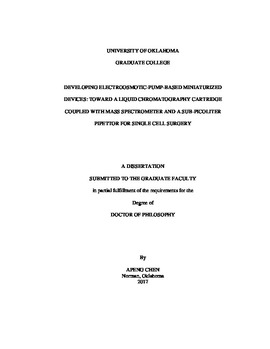| dc.description.abstract | There has been increasing interest on miniaturizing high performance liquid chromatography (HPLC), since it can reduce the costs of instrument manufacturing and perform onsite analysis. The electroosmotic pump (EOP) is one of the most promising micropumps that can be used for HPLC due to its compact size, and low fabrication cost. We have recently reported an electroosmotic pump (EOP), consisting of monolithic columns, capable of producing more than 1200 bar output pressure. However, when it pumps organic solutions, the flow rate becomes unstable. Hence, we here report two ways to address the issue.
In the second chapter, we describe the first method. A ten-port valve was used to create a gradient profile by inserting it between an EOP and an injection valve (Figure 2 1). In the position as shown in Figure 2 1, an eluent in loop 1 was delivered to the separation column, while a higher concentration eluent was loaded into loop 2. Once the valve was switched, loop 2 was connected to the separation column, while the next gradient eluent was loaded into loop 1. Repeating these steps formed a gradient profile that was close to linear.
In the second method (Chapter 3), we added a mixing chamber after the EOP (Figure 3 1). When a high voltage was applied, the EOP withdrew a series of gradient eluents having different elution strengths via a selection valve. The eluents went through the mixing chamber and towards to EOP. Once an opposite high voltage was applied, the EOP pushed the eluents out, through the mixing chamber again, and towards to the separation column. During the movements of these eluents (i.e., back and forth in the mixing chamber, as well as inside of capillary assembly), a smooth gradient profile was formed. Since it is possible to change the size of mixing chamber, the number of eluents, as well as the volume, concentration, and the movement pattern (i.e., duration, velocity, and movement style), any desired gradient profile can be generated. Finally, we incorporated either approach with HPLC and a mass spectrometer for the separation and analysis of peptides and proteins.
In the fourth chapter, we described the application of EOP on single cell analysis. There has been increasing interest and requirement of single cell analysis with the development of bioanalytical and biochemical methods, since average data from population eliminate the heterogeneity of single cells. However, there are few methods currently available that can transfer mass into, and especially out of single cells under precise control. In this study, we developed a monolith-based EOP-driven pipettor (EDP), which was able to inject solutions into and withdraw cellular contents out of single cells down to ~250 fL. We subsequently demonstrated an application of the EDP in real-world samples by quantitative analysis of cholesterol from zebrafish embryos, and 89.3%-91.7% of the embryos survived after surgery that was performed at different developmental stages. Since the compatibility of the pump solution, an EDP has potential to be directly coupled with mass spectrometry. Taken together, our results showed an EDP can be used for living-single-cell analysis. | en_US |
